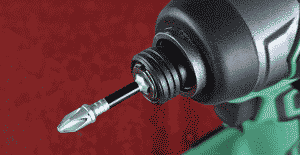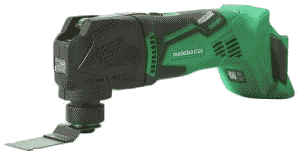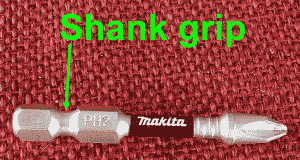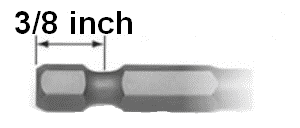 (Update: thanks to a comment below from alert reader Bernie Greenspan, I eventually located ANSI standard B107.4 which standardized the ¼-inch quick-release hex shank in 1982.)
(Update: thanks to a comment below from alert reader Bernie Greenspan, I eventually located ANSI standard B107.4 which standardized the ¼-inch quick-release hex shank in 1982.)
Many people who try to do projects and repairs around the house or around the office would, I think, report that they experienced two events involving power tools that changed things a lot. One’s life divides into “how it was before I got an oscillating tool and how it was after” and “how it was before I got an impact driver and how it was after”. As will be discussed below, the impact driver uses driver bits and drill bits having a “¼-inch quick-release hex shank”. The main point of this blog article is to raise two seemingly unanswerable questions:
-
- When did the ¼-inch quick-release hex shank begin?
- Who thought of the ¼-inch quick-release hex shank?
 Oscillating tool. The oscillating tool, shown at right, is remarkably different from any other work tool. Compared with other powered cutting tools, it poses much less risk of injury to the user. It can do plunge cuts that saws cannot. It can remove failed grout from tile spacings, or failed caulk from seams. With a diamond-tipped blade it can cut cast-iron pipes that are inside walls, needing only a modest-sized opening in the wall surface. For cutting openings in drywall it is cleaner and more accurate than a drywall saw. With a sanding pad it can do fine or coarse sanding, fitting into tight corners. With an appropriate cutting blade it can cut wood or plastic or metal. Many projects and repairs that one might undertake can be done much faster, more accurately, and more safely using this tool when compared with the other tools that one would have used beforehand. Most people who add an oscillating tool to their toolbox say that it changed everything about how they do tasks around the home or office.
Oscillating tool. The oscillating tool, shown at right, is remarkably different from any other work tool. Compared with other powered cutting tools, it poses much less risk of injury to the user. It can do plunge cuts that saws cannot. It can remove failed grout from tile spacings, or failed caulk from seams. With a diamond-tipped blade it can cut cast-iron pipes that are inside walls, needing only a modest-sized opening in the wall surface. For cutting openings in drywall it is cleaner and more accurate than a drywall saw. With a sanding pad it can do fine or coarse sanding, fitting into tight corners. With an appropriate cutting blade it can cut wood or plastic or metal. Many projects and repairs that one might undertake can be done much faster, more accurately, and more safely using this tool when compared with the other tools that one would have used beforehand. Most people who add an oscillating tool to their toolbox say that it changed everything about how they do tasks around the home or office.
 Impact driver. The impact driver, shown at right, is a cordless power tool which appears, at first glance, to be a cordless drill. Closer inspection reveals, however, that it lacks a familiar drill chuck. Most cordless drills these days have a “clutch” which permits the user to rotate a numbered ring to limit the torque that the drill applies to the task. But the impact driver lacks such a clutch. The impact driver thus seems to be an inferior cousin to the drill.
Impact driver. The impact driver, shown at right, is a cordless power tool which appears, at first glance, to be a cordless drill. Closer inspection reveals, however, that it lacks a familiar drill chuck. Most cordless drills these days have a “clutch” which permits the user to rotate a numbered ring to limit the torque that the drill applies to the task. But the impact driver lacks such a clutch. The impact driver thus seems to be an inferior cousin to the drill.
When the user gains some experience with the impact driver, however, it becomes clear that the impact driver has some striking advantages. The first is that the user can change from one driver bit or drill bit to another instantly. The user who has been spoiled by this quick-change feature of the impact driver will soon get the feeling that manipulating a drill chuck to insert or remove a drill bit or driver bit now takes an eternity to do.
The impact driver is lighter in weight, and is physically smaller, than the otherwise equivalent cordless drill. This makes it easier to work overhead, or in tight spots.
Yet another advantage of the impact driver is that the hex bit never works loose or slips in the “hex chuck” of the impact driver, and never gets misaligned as a cylindrical-shank bit might do in an ordinary drill chuck.
A final striking difference is that the available torque developed by the impact driver is much greater than the torque developed by an otherwise equivalent cordless drill.
 Which brings us to the ¼-inch quick-release hex shank. Most of the drill bits and driver bits that one might have in one’s tool kit are useless with the impact driver. This highlights yet another apparent disadvantage of the impact driver when compared with an ordinary drill with a chuck — the only bits that can be used with the impact driver are bits that have what is called a “¼-inch quick-release hex shank”.
Which brings us to the ¼-inch quick-release hex shank. Most of the drill bits and driver bits that one might have in one’s tool kit are useless with the impact driver. This highlights yet another apparent disadvantage of the impact driver when compared with an ordinary drill with a chuck — the only bits that can be used with the impact driver are bits that have what is called a “¼-inch quick-release hex shank”.
The ¼-inch quick-release hex shank, shown above right, has a hexagonal cross section with a distance between flats of ¼ inch. Importantly, there is a characteristically shaped gripping area on the shank, as shown in the photograph. This permits the “hex chuck” of the impact driver to grip the bit securely, yet also permits a quick release of the bit.
 Update: it turns out that ANSI standard B107.4, dating from 1982, defines the ¼-inch quick-release hex shank. The important thing that you would need to know is the distance from the gripping groove to the end of the bit. To get the answer, you can pay $45 for a DRM-protected PDF copy of that standard, or you can read on. The distance is 3/8 inch. There is also a Japanese standard in which the distance is 14 millimeters, or just over 1/2 inch.
Update: it turns out that ANSI standard B107.4, dating from 1982, defines the ¼-inch quick-release hex shank. The important thing that you would need to know is the distance from the gripping groove to the end of the bit. To get the answer, you can pay $45 for a DRM-protected PDF copy of that standard, or you can read on. The distance is 3/8 inch. There is also a Japanese standard in which the distance is 14 millimeters, or just over 1/2 inch.
Most standardized shapes and fittings have catchy names that are tied to the company or person who first devised them, and there is usually a well-understood time of the origin. The “Allen wrench” was, oddly enough, started by somebody named Allen, and it is well documented that this happened in 1909. The “Phillips-head screw” was oddly enough, created and standardized by somebody named Phillips, and this happened in the 1930s. The blades that fit into an oscillating tool have a mounting shape that was created by the Fein company in about 1967.
Conspicuous by its absence, however, so far as I can see, is any hint or suggestion in Wikipedia or across the Internet generally as to who created the ¼-inch quick-release hex shank, or when this happened.
I will be delighted if an alert reader will post a comment explaining who created or standardized this ¼-inch quick-release hex shank, or when they did it. Ideally the comment will provide a citation to some authority.

Carl, after a quick search …
Perhaps US4900202 and US5013194 granted in 1990 and 1991 to James L. Weinhold of Minnetonka, MN are the patents you are seeking.
I have never disassembled my impact driver, but the drawings and descriptions seem plausible for my tools. Plus, the patents would be expired and thus available to all of the various impact driver makers.
Thank you for commenting! Yes, these two patents shed some light on the questions. I note that neither of these two patents is directed to the shank design itself — just a chuck. And there are other patents on chucks for such shanks. It turns out that the shank design itself dates from 1982, standardized in ANSI standard B107.4-1982.